Sales Agreement Samples
-

Business Sales Agreement
download now -

Car Sales Agreement
download now -

Conditional Sales Agreement
download now -

Aircraft Sales Agreement
download now -

Product Sale Agreement
-

Vehicle Sale Agreement
-

Sample Binding Sales Agreement
-

Basic Sales Transaction Agreement
-

House Sale Agreement
-

Horse Sales Agreement
-

Real Estate Sales Agreement
-

Room Sales Agreement Example
-
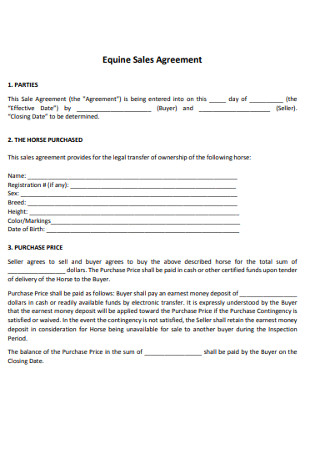
Equine Sales Agreement
-

Sales Purchase Agreement
-

Sales Amendment Agreement
-

Bill of Sale security Agreement
-

Sales Agency Agreement
-

Electricity Sales Agreement
-

House Property Sale Agreement
-

Motor Vehicle Sale Agreement
-
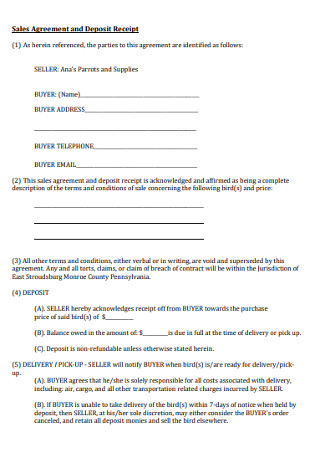
Sales Agreement and Deposit Receipt
-

Retail Sales Agreement
-
 _
_Natural Gas Sales Agreement
-

Wholesale Sales Agreement
-

Coal Sales Agreement
-

Family Sales Purchase Agreement
-

Master Rack Sale Agreement
-
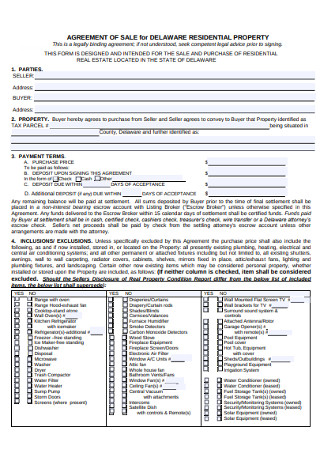
Residential Property Sales Agreement
-

Conditional Sales Agreement
-

Sample Online Sale Agreement
-

Power Sales Agreement
-

Sales Deposit Agreement Form
-

Still-water Farm Sales Agreement
-

Equipment Sale Agreement
-

Mobile and Home Purchase Agreement
-

Sales Employment Agreement
-

Gas Sales Agreement
-

Advertising Sales Agreement
-

Ticket Sale Agreement
-

Conditional Sales Agreement in DOC
-

Asset Sales Agreement
-

Preliminary Sales Agreement
-

Sample Sales Employee Agreement__
-

Memorandum of Timber Sales Agreement
-

One-Time Sale of Goods Agreement
-

Sales Agreement Form
-
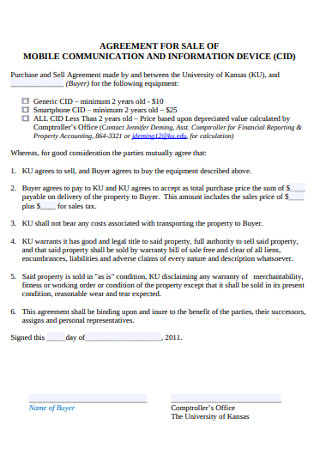
Mobile Device Sales Agreement
-

Electronic Sales Agreement
-

Group Sales Agreement
-

Re seller Sales Agreement
-

Second Hand Boat Sale Agreement
FREE Sales Agreement s to Download
Sales Agreement Format
Sales Agreement Samples
What is a Sales Agreement?
Purposes of a Sales Agreement
Types of Sales Agreements:
How to Create a Sales Agreement
FAQS
When is a sales agreement required?
What happens if a party breaches the sales agreement?
How do sales agreements protect buyers and sellers legally?
What are the essential components of a sales agreement?
How do sales agreements differ from purchase orders?
Can a sales agreement be modified after signing?

Download Sales Agreement Bundle
Sales Agreement Format
This Sales Agreement (“Agreement”) is made and entered into on [Date] by and between:
1. Seller Information
Name: [Seller’s Full Name]
Address: [Seller’s Address]
Email: [Seller’s Email]
Phone: [Seller’s Phone Number]
2. Buyer Information
Name: [Buyer’s Full Name]
Address: [Buyer’s Address]
Email: [Buyer’s Email]
Phone: [Buyer’s Phone Number]
1. Description of Goods/Services
The Seller agrees to sell, and the Buyer agrees to purchase the following goods/services:
- Item Name/Description: [Enter Product/Service Name]
- Quantity: [Enter Quantity]
- Unit Price: [Enter Price per Unit]
- Total Amount: [Enter Total Price]
- Specifications/Features: [If applicable, mention product details, model number, or other specifics.]
2. Payment Terms
- Total Price: [Insert Total Amount in Words and Numbers]
- Payment Method: [Bank Transfer, Cash, Check, etc.]
- Deposit: [Yes/No] Amount: [Specify Amount]
- Balance Due Date: [Insert Date]
- Late Payment Penalty: [Percentage or Flat Fee]
3. Delivery Terms
- Delivery Date: [Insert Date]
- Delivery Location: [Insert Delivery Address]
- Shipping Method: [Courier, Transport, In-Person, etc.]
- Risk of Loss: The risk of loss of the goods passes to the Buyer upon [Insert Delivery Method, e.g., receipt of goods, shipment, etc.].
4. Inspection and Acceptance
- The Buyer has [insert number] days from the date of delivery to inspect the goods.
- If the Buyer identifies any defects or non-conformity, they must notify the Seller in writing within this period.
- If no claim is made, the goods will be deemed accepted.
5. Warranties and Representations
- The Seller warrants that the goods are:
- Free from defects in materials and workmanship.
- Comply with industry standards and specifications.
- The Seller disclaims any other warranties, including implied warranties, except those explicitly mentioned herein.
6. Title and Ownership
- Title to the goods will be transferred to the Buyer upon full payment of the total price.
- Until full payment is received, the Seller retains ownership of the goods.
7. Indemnification and Limitation of Liability
- The Buyer agrees to indemnify and hold the Seller harmless from any claims, damages, or liabilities arising from the use, resale, or modification of the goods.
- The Seller’s liability is limited to the amount paid by the Buyer under this Agreement.
8. Termination and Cancellation
- This Agreement may be terminated by:
- Mutual agreement of both parties.
- Failure of either party to meet their obligations (e.g., non-payment, failure to deliver).
- Force Majeure: Either party may cancel or delay performance due to unforeseen events like natural disasters, pandemics, strikes, etc.
9. Dispute Resolution
- Any dispute or claim arising from this Agreement shall be resolved by:
- Negotiation: Both parties agree to negotiate in good faith to resolve any disputes.
- Mediation/Arbitration: If negotiation fails, disputes will be resolved through [choose: mediation, arbitration, or legal action] under the laws of [State/Country].
10. Governing Law
This Agreement shall be governed by and construed in accordance with the laws of [State/Country].
11. Entire Agreement
This document represents the entire agreement between the Buyer and Seller. No modifications, amendments, or changes shall be valid unless agreed upon in writing by both parties.
12. Signatures
IN WITNESS WHEREOF, the parties have executed this Sales Agreement on the date first written above.
Seller
Signature: ___________________________
Name: [Insert Seller’s Name]
Date: _______________________________
Buyer
Signature: ___________________________
Name: [Insert Buyer’s Name]
Date: _______________________________
What is a Sales Agreement?
A sales agreement is a formal contract between a buyer and a seller that outlines the terms of a sale. It ensures mutual understanding and legal protection for both parties. This document details critical information such as the items being sold, the payment amount, delivery date, and dispute resolution terms. Sales agreements are often used in real estate, vehicles, and large equipment sales but can apply to other goods or services. It provides a legal framework to resolve conflicts if disputes arise. You can also see more on Sale and Purchase Agreement.
Purposes of a Sales Agreement

1. Legal Protection
A sales agreement serves as a legally binding document that holds both the buyer and seller accountable for their responsibilities. It provides legal protection by clearly stating the obligations of each party and serves as evidence in case of disputes or legal claims. You can also see more on Purchase Agreement.
2. Clarity of Terms and Conditions
The agreement defines essential terms like payment schedules, product descriptions, delivery timelines, and refund policies. This clarity ensures that both parties understand their roles, reducing confusion or miscommunication.
3. Dispute Prevention and Resolution
By clearly outlining all aspects of the transaction, a sales agreement helps prevent disputes. If disagreements occur, the agreement serves as a reference point to resolve issues through arbitration, mediation, or other specified methods. You can also see more on Retail Agreement.
4. Proof of Ownership and Sale
The agreement acts as proof of ownership for the buyer, especially in large transactions like property, vehicles, or business assets. This document is crucial for legal recognition, registration, and resale of purchased goods or services.
5. Defining Responsibilities and Obligations
A sales agreement outlines the rights and obligations of both parties, such as payment deadlines, delivery dates, and product conditions. This structure ensures that both parties fulfill their roles in the transaction.
6. Risk Mitigation
The agreement addresses potential risks, such as delays in delivery, product defects, or missed payments. It provides predefined solutions for such risks, reducing financial loss and ensuring both parties are aware of their liabilities. You can also see more on Bill of Sale Contracts.
7. Customized Terms and Conditions
Each sales agreement can be tailored to the unique needs of the transaction. It allows both parties to include specific clauses on warranties, installment payments, product quality, and delivery deadlines, making the contract more flexible and personalized.
8. Payment Structure and Schedule
The agreement specifies payment terms, including the total amount, payment method, and deadlines for installments. This ensures timely payments and holds both parties accountable for their financial commitments. You can also see more on Bulk Sale Agreement.
Types of Sales Agreements:
- Real Estate Sales Agreement: Used for property or land purchases.
- Vehicle Sales Agreement: Covers the purchase of cars, motorcycles, or other vehicles.
- Business Sales Agreement: Used when buying or selling a business or its assets.
- Product Sales Agreement: Used for selling goods like electronics, furniture, or bulk products.
- Service Sales Agreement: Used for selling services like consulting, repairs, or freelance work. You can also see more on Business Purchase Agreement.
How to Create a Sales Agreement
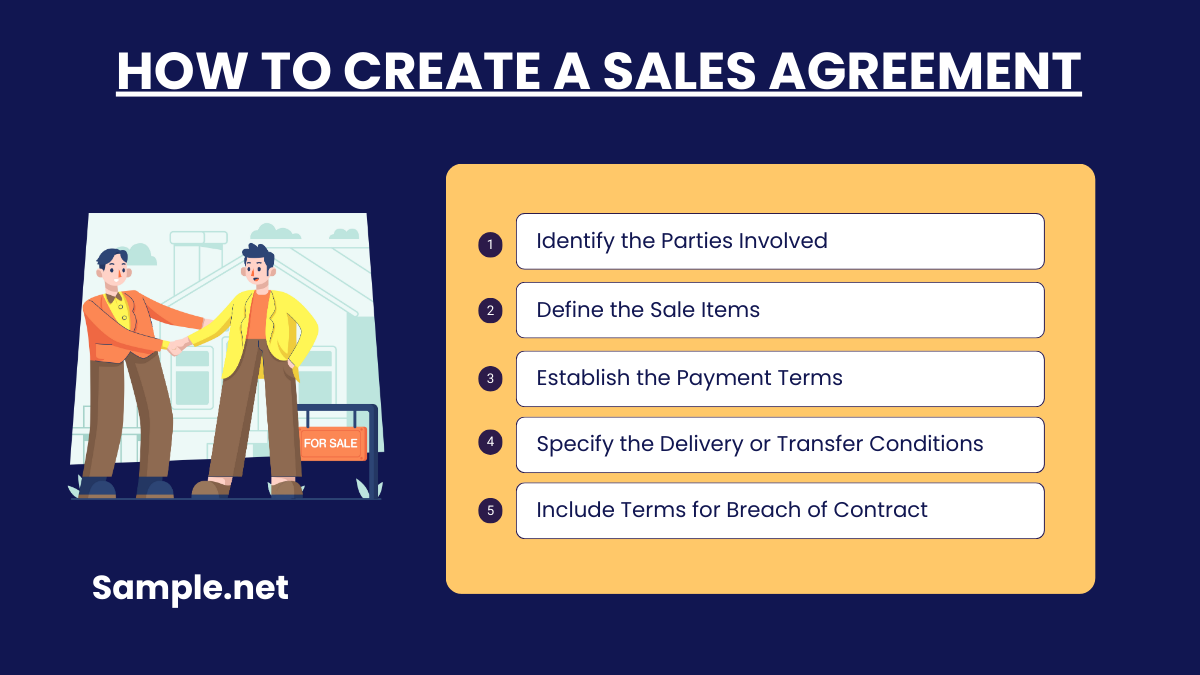
Step 1: Identify the Parties Involved
Begin by clearly specifying the buyer’s and seller’s full legal names and addresses. This step ensures that the parties are easily identifiable in case of any legal issues or disputes. Their roles (buyer or seller) should also be mentioned. This section confirms the parties entering the contract.
Step 2: Define the Sale Items
Clearly describe the product, property, or service being sold. Include details like product description, quantity, condition, or any specific attributes. For property, mention the exact location and other key specifics. These details prevent misunderstandings about what is being bought or sold. You can also see more on Purchase Contract.
Step 3: Establish the Payment Terms
Outline the payment structure, including the amount, payment method (cash, bank transfer, etc.), and payment deadline. If installments are allowed, list the due dates for each payment. This section protects both parties from payment-related issues.
Step 4: Specify the Delivery or Transfer Conditions
Clearly define when, where, and how the buyer will receive the goods or services. For example, indicate if delivery is required, whether the buyer will collect the item, and if delivery costs are included in the price. This step avoids confusion and ensures smooth transactions. You can also see more on Buy and Sell Agreements.
Step 5: Include Terms for Breach of Contract and Dispute Resolution
Define what happens if one party fails to meet their obligations. Will there be penalties, cancellation rights, or refund options? Include how disputes will be resolved, such as through arbitration or mediation. This step helps prevent costly court battles.
A sales agreement is a critical legal document for buyers and sellers. It sets clear expectations, provides legal protection, and prevents misunderstandings. This contract is essential for high-value transactions like real estate, vehicles, and business sales. By clearly defining all aspects of the sale, such as payment terms, delivery, and dispute resolution, it ensures a smooth and hassle-free experience for both parties. Investing time in a well-drafted sales agreement can save money, effort, and stress in the future. You can also see more on Business Sale Contract.
FAQS
When is a sales agreement required?
A sales agreement is required for high-value sales like property, vehicles, or large purchases. It’s also used when terms like payment installments, delivery timelines, or dispute resolution need to be clearly outlined.
What happens if a party breaches the sales agreement?
If a party breaches the sales agreement, they may face penalties, cancellation of the sale, or legal action. The agreement usually defines how disputes are resolved, whether through mediation, arbitration, or legal proceedings. You can also see more on Vehicle Sale Agreement.
How do sales agreements protect buyers and sellers legally?
A sales agreement protects buyers by ensuring the product or service is delivered as promised. It also safeguards sellers by ensuring they receive payment as agreed. In case of a breach, both parties have the right to legal action. Legal clauses, such as payment schedules, breach terms, and dispute resolutions, provide clear remedies in case of any issues.
What are the essential components of a sales agreement?
Key components include identifying the buyer and seller, defining the item being sold, outlining payment terms, specifying delivery conditions, and addressing dispute resolution. Each part ensures transparency and provides clear instructions if disputes occur. The more detailed the agreement, the stronger the legal protection for both parties. You can also see more on Agent Agreement.
How do sales agreements differ from purchase orders?
A purchase order (PO) is a document issued by the buyer to request goods from a supplier, while a sales agreement is a legal contract that finalizes the sale. POs can be part of the ordering process, but sales agreements go beyond orders to legally bind both parties. Sales agreements are usually more detailed than POs.
Can a sales agreement be modified after signing?
Yes, but both parties must agree to the modifications in writing. Changes to payment schedules, delivery terms, or other key clauses must be documented and signed by both parties to remain legally binding. This prevents future disputes about contract changes. You can also see more on Business Agreements.
